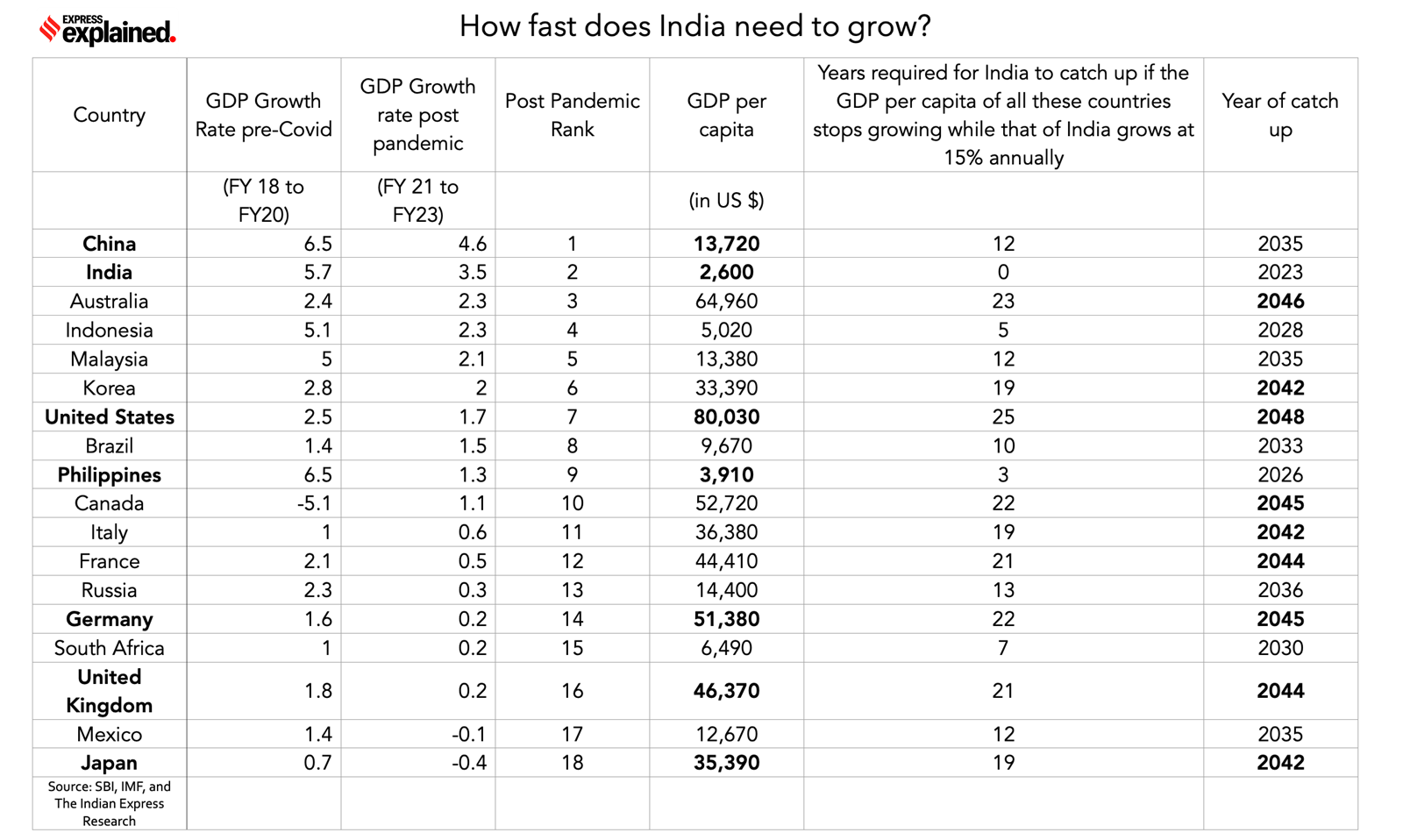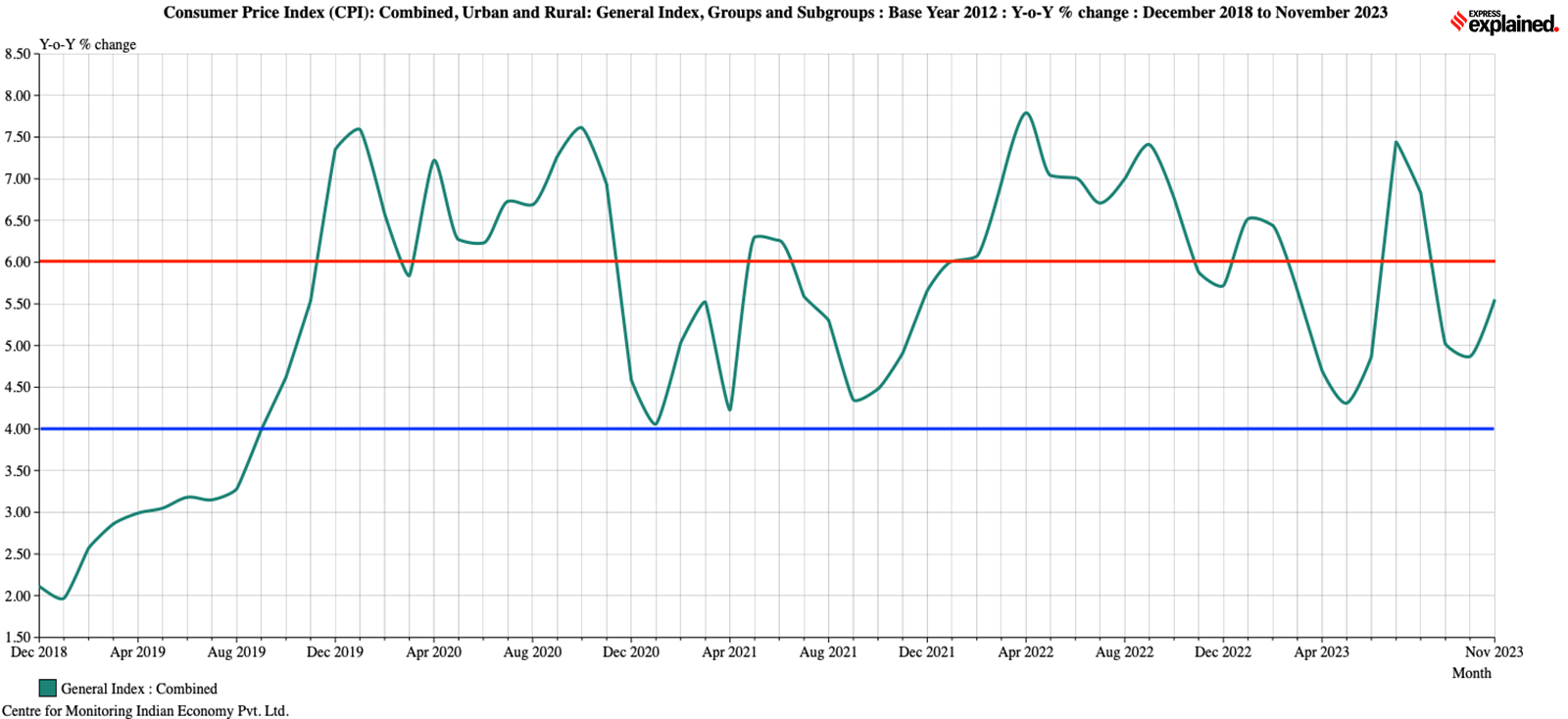Explanation of the hadith High growth, low unemployment, contained inflation: Will India hit a triple-double in 2023?

This is the latest edition of Explanation of speaking In 2023, and as such, it is dedicated to looking at some of the key stories of the past 12 months. It provides a good opportunity for readers to reconsider some of the major interpreters.
In any year, there are three major concerns for the Indian economy: driving GDP growth, maintaining price stability (read containing inflation), and reducing unemployment.
2023 has started on a somewhat nervous note in all three respects.
Rising inflation, in particular, was the biggest story of 2022. By the time 2023 rolled around, inflation had begun to decline. Although there were concerns – that higher prices had trickled down to the broader economy, meaning Indian consumers would have to pay higher prices even if food and fuel prices fell – the focus was increasingly shifting to… Maintaining India’s GDP growth momentum There was a growing realization that higher interest rates would begin to reduce economic activity and exacerbate the already poor unemployment situation in the country.
At the global level too, the mood was bleak. By the end of 2022, there was a consensus that much of the developed world was likely to plunge into recession. A recession is said to occur when an economy’s economic output shrinks (rather than grows) for two consecutive quarters (or a total of 6 months).
It’s certainly not even close Recession conditionsIndia was facing its own challenges.
this piece He explained the contents and concerns of India’s GDP growth as it stood at the beginning of 2023. Simply put, private consumption expenditures, the largest driver of India’s GDP growth (contributing about 55% to 60% of India’s annual output), have barely grown in 2023. The previous three years. Growth in investment spending (money spent toward creating productive capacity, the second-largest driver of GDP growth) was a little better, but most of it was just replacing old investment. Government spending, the third driver, was more stagnant than the first private driver.
With regard to unemployment, the situation remained worrying. Data from the Center for Monitoring Indian Economy (CMIE) revealed that Total number of employees In India at the end of December 2022 it was less than the total number of employees at the beginning of 2016.
While these may be the overall concerns, there are other factors that also indicate vulnerable feelings. In the first months of 2023, Indian stock markets have lagged behind most of their peers – a situation not helped by the Adani group of companies’ Hindenburg Research report. And overall consumer sentiment as well It was mostly negative Back to 2015.
Amazing ending
In sharp contrast, the Indian economy ended the calendar year on a high note. It seems that India has recorded a hat-trick at the macroeconomic level.
Consider the following:
1. Broad-based inflation has continued its downward trend and is now within the RBI’s comfort zone (2% to 6%). Talks about raising interest rates “Falcons stops” It has given way to rumblings about lending rates being cut faster than expected. This price stability has been achieved despite geopolitical tensions in West Asia.
2. Contrary to fears, India’s GDP growth, rather than slowing down Surprised on the upside. There are hardly any forecasters in town, and that includes the Reserve Bank of India, which has not had to revise India’s GDP estimates in a hurry.
3. Official unemployment data – provided by the Periodic Labor Force Survey (PLFS) – showed that India has not only managed to reduce the unemployment rate, but has also seen more and more women joining the labor force.
As for sentiment, so were the stock markets Capping all-time highs Over the past two months even as voters resoundingly supported Prime Minister Modi’s leadership in the recently concluded state assembly elections.
Hattrick: How so?
There are two ways to look at the achievements of the Indian economy in 2023.
If one looks at the Indian economy in the context of the global economy, 2023 marks the year in which India began its rise towards becoming a developed nation.
While most developed countries are happy to avoid a recession in 2023, India has easily taken on the mantle of the world’s fastest-growing economy. In fact, a World Bank report stated that the decade between 2020 and 2030 has Sanaa the lost decade for the global economy. While the slowdown elsewhere makes it relatively easier for India to outperform others, it also shows that India is one of the few countries that is expected to grow well despite weak global growth.
India’s high inflation rate in the recent past can be ruled out not only for the fact that it is a developing economy and like most fast-growing economies, India should also be allowed to have slightly high inflation but also because the shocks of the last three years have affected the Indian economy. Away from the evils of high (in fact historical) inflation.
Regarding unemployment also, India has shown improvement. Moreover, given the huge youth bulge, the same workforce, if skilled, could easily become India’s greatest source of power.
However, there is another side too.
If we examine each of the three macroeconomic achievements more closely, we find several points of concern. Each of these has been highlighted throughout the year in different editions of ExploreSpeaking.
Let’s start with GDP growth (Because it was undoubtedly the greatest achievement)
While addressing the US Congress, Indian Prime Minister Narendra Modi stated that when he first visited the US as Prime Minister, India was the world’s tenth largest economy and eight years later it became the world’s fifth largest economy. Moreover, he said that soon India It will be the third largest economy in the world.
This is clearly a great achievement for India, and economic growth should never be taken for granted. However, it is important to understand what the fifth largest economy is called Meaning for the average Indian citizen.
Likewise, cf table Below (originally download here) to understand how far India lags behind most of its peers, and why India has no choice but to grow faster than the rest of the world.
 How fast does Indian GDP need to grow compared to the rest of the world?
How fast does Indian GDP need to grow compared to the rest of the world?
Moreover, despite the astonishing growth in the headlines, – Weak growth in private consumption It continues to be a fly in the ointment of India’s GDP. that Analysis of Indian economy In the first nine years of the Modi government, he showed how the income growth of ordinary Indians moderated compared to the ten years of the United Progressive Alliance government.
In fact, the average Indian is not the only one suffering. Even the very wealthy were like that Leaving India in large numbers.
Another problem that hinders growth in India is that the private sector does not yet feel sufficient enthusiasm to start new investments in all fields. Researchers at Bank of Baroda I followed this case closely and came to some troubling findings in July. like december, Bank of Baroda found The K-shaped recovery in private consumption was leading to a similar K-shaped recovery in private investment as well.
But despite India’s growth surprise, GDP calculations continue to cause controversy. read this analysis From the quarterly GDP data to understand why many are skeptical of the GDP data.
Finally, there is the introduction of a new term: Hindutva rate of economic growth.
On unemployment
First, although the official PLFS data shows a better picture than the CMIE data, this is only true if one does not scratch beneath the surface. like this piece He explained that although official employment data in India shows improvement, the quality of jobs being created is getting worse even as monthly earnings have remained largely stagnant since 2017.
The truth is the relationship between India’s GDP growth and employment generation for its people It becomes weaker over time.
In fact, if one looks at the CMIE data – which is released every week versus the PLFS which is released a quarter to a year apart – several worrying trends emerge.
For example, India has become a young country but with… Aging workforce. India’s workforce is becoming increasingly… Male dominated. Contrary to popular belief, the only category where Indian entrepreneurship is on the rise is… ‘self employed’ The first, which refers to jobs such as taxi drivers, astrologers, etc., reflects poorly the broader economic conditions in India.
Although the current government has largely ignored unemployment concerns for most of its tenure, over the past year or so, one can only see the Prime Minister organizing ‘Rozgar Melas’. But is this the solution to India’s employment problems? read this.
A related topic is poverty alleviation.
In his Independence Day speech this year, Prime Minister Modi said that in the first five-year term of his government, 13.5 crore Indians have been lifted out of poverty and are on their way to becoming the middle class. But since there has been no official update on India’s poverty figures since 2011, how was this calculated? Moreover, has the pace of poverty reduction improved over time? Read this piece to learn more.
To contain inflation
the Schedule The following shows the extent of India’s success in achieving price stability. The red line corresponds to the 6% upper bound of the RBI’s comfort zone, while the blue line corresponds to 4% – the RBI’s target rate.
 The CPI changes over the years, from December 2018 to November 2023
The CPI changes over the years, from December 2018 to November 2023
While inflation fell below 6% on several occasions in 2023, the reality is that consumer inflation has not once fallen to the 4% mark since September 2019 – that’s four straight years or 48 months in a row.
These high levels of inflation in previous years have led to some strange situations. For example, in June and July of this year, tomato prices skyrocketed, however, tomato prices remained high The inflation rate for tomatoes was negative.
Moreover, these persistently high levels of inflation have not only eroded people’s purchasing power, but have also made many question the desirability of inflation. Inflation targeting system For a country like India or in fact, Effectiveness of RBI Itself. Interestingly, if one follows this theme, one could justifiably argue that the RBI’s actions may indeed be so Exacerbating inequality.
It is obviously easy (and largely true) to say that 2023 has been a great year for the Indian economy from the point of view of macroeconomic stability. But even a gentle examination of the data throws up a much more complex picture.
etc.
There were many articles that were either about some less discussed aspects of the Indian economy or about developments in other economies or indeed about some economists or some economic concepts. For example,
👉 India’s loss in the ICC Cricket World Cup led to this explanatory article on (defunct) Law of averages.
👉 We also asked Whether Thakur should have killed Gabbar, How might this affect the rule of law?
👉 There was a piece on Economics of climate change in India.
👉 One about Argentina’s new president, Javier Miley Dollarization – His radical policy to save Argentina’s economy.
👉 Finally, one this year Nobel Prize in Economics by Claudia Goldenwhich explained how marriage, parenthood, and the birth control pill affect women in the workforce.
Hoping that 2024 will be a better year than 2023, I wish all readers a very Happy New Year!
See you in 2024, and don’t forget to get this mask!
Kanakamani
